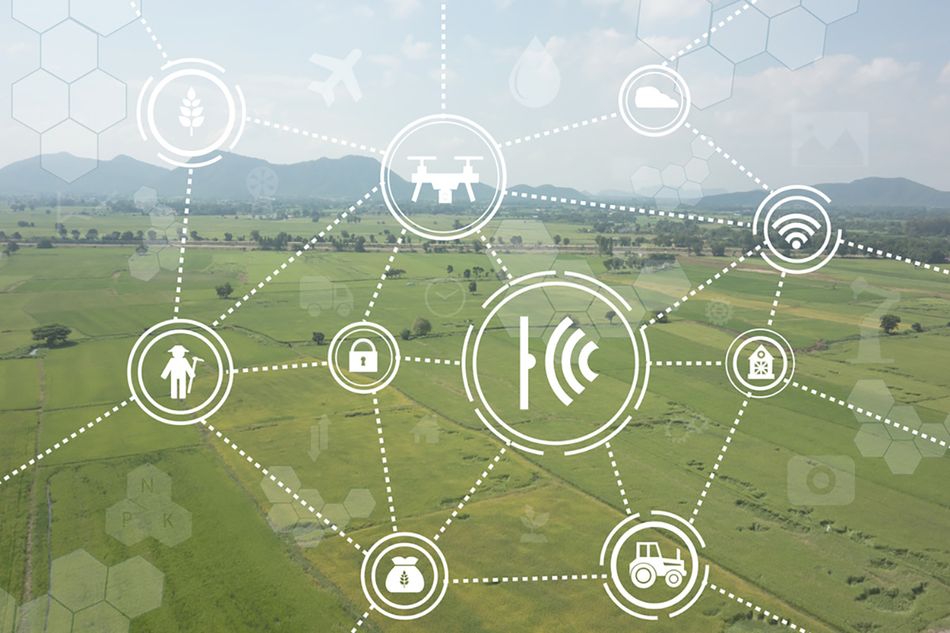Digital Technologies That Realize the Diversification of Primary Industries
The diversification of primary industries refers to the aim to have producers (primary industries) also perform processing (secondary industries) and distribution and sales (tertiary industries) in order to diversify their management
What Is the Diversification of Primary Industries?
The diversification of primary industries refers to the aim to have producers (primary industries) also perform processing (secondary industries) and distribution and sales (tertiary industries) in order to diversify their management. The purpose of this is to curb price fluctuations with the wholesale of produce to increase added value and to improve the income of producers while revitalizing regions at the same time. This is achieved by integrating the primary, secondary, and tertiary industries.
Current State of Agriculture and the Necessity of the Diversification of Management
The number of agricultural workers is continuing to decline in most countries around the world. For example, it is expected that the number of agricultural workers in the EU will decline by approximately 28% between 2017 and 2030*1. Meanwhile, the number of farms in the US fell from 7.6 million in 1950 to 2.06 million in 2000. That is a reduction of approximately 73%*2. Furthermore, the number of agricultural workers in Japan dropped from 4.82 million in 1990 to 2.097 million in 2015. That is a decline by more than half over 25 years*3. At the same time, the age of agricultural workers is rising. It is said that the average age of agricultural workers in developed countries is around 60 years old*4. The reduction in the number of agricultural workers and their increasing age has led to a decrease in the income of farms. That is a major cause of a worsening vicious cycle.
Phenomena like this make it difficult to supply food in a stable manner, which is the original role of agriculture. It also has a major impact on national security.
Accordingly, various initiatives are being promoted in each country to realize the diversification of management that integrates production, processing, and sales while promoting the digital transformation of agriculture that proactively utilizes digital technologies. The aim of this is to stop this vicious cycle and to conversely encourage economic development.
- Latest Outlook on Agriculture by the European Commission
- US Department of Agriculture (USDA) Economic Research Service
- Japan Ministry of Agriculture, Forestry and Fisheries' 2015 Agriculture and Forestry Census Report
- Food and Agriculture Organization (FAO)
Benefits from the Diversification of Primary Industries
The benefits from the diversification of primary industries include the creation of jobs, the revitalization of local communities, and the branding of produce in addition to an improvement in income. We describe these benefits here.
Stabilization of Prices and Improvement in Income
Producers consistently perform processing, distribution, and sales. Therefore, earnings are not affected by price changes in the wholesale market. Normally, non-production processes are performed by different business operators. This means the price rises as the number of business operators involved increases. To that end, producers must keep their earnings low to stably provide produce to consumers. In contrast to this, it is possible to reduce intermediary costs by diversifying primary industries. That makes it possible to provide produce to consumers at low prices while achieving an increase in earnings. Furthermore, producers possess the right to determine prices, so it is possible to stabilize their income.
Creation of Jobs and Revitalization of Local Communities
When primary industries are diversified, producers also perform processing, distribution, and sales. As a result, the volume of business increases, and thus jobs are created in producing areas. Moreover, employees are needed throughout the year in non-production departments. Accordingly, stable employment is possible. Furthermore, as it is possible to ensure non-production revenue all year round, corporate management is stable. In addition, stable employment and the stabilization of management prevents the hemorrhaging of the population to city areas, and thus can greatly contribute to the revitalization of local communities.
Branding of Produce
It is possible to brand produce with the uniqueness of the producing area and processing technologies as their selling points by producers performing the processing, distributing, and selling. For example, producers can achieve differentiation from other products with branding by highlighting the use of fresh ingredients and the manufacturing methods they are committed to as their selling points. This makes it possible to improve the added value.
Challenges in the Diversification of Primary Industries
The diversification of primary industries mainly refers to starting new businesses. It is necessary to understand the disadvantages in advance and to solve each challenge when starting a new business. We describe here the challenges of diversification of primary industries.
Large Initial Investment and Running Costs Are Required
As in the past, the stable supply of produce is of the utmost importance even in the diversification of primary industries. It is necessary to invest in automation, mechanization, processing machines, transportation machines, and other areas to stably supply produce. Moreover, it costs money to sell produce as products. Those costs include product development and packing box design to achieve differentiation with other products, responding to HACCP in terms of hygiene management, and investment in marketing.
Accurate Inventory Control and Strict Quality Control Are Required
Producers must formulate a clear production plan considering the balance of supply and demand to proceed with capital investment and contracts with sales partners in an advantageous manner. It is essential to have inventory control to accurately understand how much inventory there is in which process in the route from production to sales to formulate a clear production plan. It is also important to have quality control such as with best-before and expiry dates of products in inventory. Supply shortages and surplus inventory will arise without a clear production plan, and can cause a decline in earnings due to the termination of contracts with sales partners and an increase in discarded products.
Specialized Knowledge in Each Field Is Required
In most cases, producers have a wealth of production technology, knowledge, and experience. However, knowledge relating to processing, distribution, and sales that they have not been involved in before is unknown territory for them. Even if products are completed after production and processing, if problems arise with the distribution and sales methods, it can lead to excess inventory. Furthermore, it is of course necessary to have knowledge different from in the past if utilizing IoT technologies aiming for automation, mechanization, and smart agriculture in terms of production technologies.
Examples of Success in the Diversification of Primary Industries
There are many challenges that need to be met to succeed in the diversification of primary industries. We introduce here some examples in which these challenges were solved to lead to success.
Example of Dairy Farming Management That Achieved the Centralized Operation of Initial Investment and a Reduction in Production Costs by Forming a Cooperative Corporation
Multiple dairy farmers formed a cooperative corporation to establish a stock company that performs large-scale dairy farming management. Centrally operating initial investment has allowed those dairy farms to introduce a large number of milking robots. That means they can save labor, perform efficient breeding management, and realize other benefits in large-scale dairy farming management. The corporation also introduced equipment to analyze the ingredients in the raw milk for each specimen in conjunction with the milking robots. This makes it possible to manage diseases and breeding, allowing for improvement of breeding efficiency and the achievement of other advantages.
In this way, the dairy farmers could form a cooperative corporation to centrally operate investment even for expensive devices that are difficult for a single farm to introduce. The corporation can also realize initiatives that require advanced digital technologies such as for improvements in breeding efficiency.
Example of a Farmer Achieving Accurate Inventory Management and Strict Quality Control with IoT Technology
IoT refers to the Internet of Things. For example, inventory control of fertilizers, agricultural chemicals, and other agricultural supplies and agriculture produce by humans is inaccurate and complicated.
It is possible to measure these items with digital equipment and to then manage them on the Internet by utilizing IoT technologies. That makes it possible to solve problems such as shipping and delivery delays due to labor shortages and errors in filling out handwritten slips or sending products. At the same time, as optimal inventory control is possible, producers can also accurately understand produce with best-before and expiry dates. This means they can avoid troubles such as with shipping and selling expired products.
Example of Utilizing Professionals in Each Field
By working while consulting with experts in each field including product development, package design, processing, distribution, and hygiene management, it is possible to tackle the efficient diversification of management. Also, by utilizing outsourcing to acquire comprehensive knowledge – including the creation of business plans, application methods for subsidies and grants, the introduction of drones, robots, computer systems, and other digital equipment, and matching of their operators – it is possible to quickly realize advanced diversification of management.
Digital Technologies Are Essential to Successful Diversification of Primary Industries
Consumer needs are diversifying and the number of primary industry workers is declining while their age is rising. Against this background, the key to achieving growth in the agriculture, forestry, and fisheries industries is how primary industry workers can accurately grasp the needs of consumers and then efficiently and effectively respond to them. It is essential to utilize management information analysis and parsing tools, perform thorough cost management, and streamline production for that.
For instance, it is an essential condition to introduce digital technologies to establish cultivated land management with CO2 sensors and soil sensors and an inventory control and quality control structure utilizing IoT technologies. That is in addition to improving the efficiency of production with robots, drones, and various automated machines.
Until now, the eyes of primary industry workers have been turned toward production processes that are upstream of the supply chain from the procurement of raw materials and parts for products to sales. The diversification of primary industries refers to tackling businesses that build relationships with distributors and consumers focusing on the entire supply chain. There are many challenges to implementing this. However, it is possible to reap significant benefits with the success of that.
Firmly grasping the basics of business to clarify strategies and properly utilizing digital technologies to develop new services is the secret to success in the diversification of primary industries in terms of creating added value and increasing income.


If you have any questions based on this article that you would like to discuss with an expert at Murata, don't hesitate to reach out. There's an entire team ready to support you with your question.




